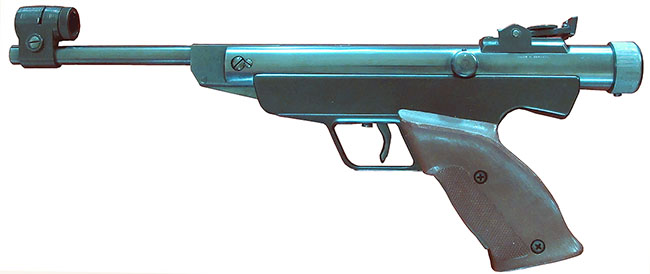
Beeman 800.
This report covers:
- Piston seals
- Diana changed seals material
- Choice of pellets
- Sig Match Ballistic Alloy
- RWS Club
- Norma S-Target Match
- Are the seals going bad?
- Note to self
- Cocking effort
- Trigger pull
- What you should have learned
- Summary
Today we look at the velocity of the Beeman model 800 target pistol. Because this pistol was made by Diana in a certain timeframe, this is an important test. In fact the same goes for Walther, and Feinwerkbau airguns, as well.
Piston seals
These three airgun companies used piston seals made from a synthetic material that hardened and rotted over time. The timeframe was the early 1970s to the early 1980s. The Beeman 800 (Diana model 6) I’m testing was made in July of 1980, according to the date stamp on the spring tube. That means the original seal that was installed was made from the bad material.
As these seals rot they start breaking apart and shooters notice light brown chunks of what appears to be a waxy substance appearing in their barrels. Eventually the gun will not push a pellet out the barrel and has to be repaired.
All those bad seals have now failed. It doesn’t matter whether the guns were shot a lot or kept in the factory box; the seals still failed. I wrote a 15-part report titled, A shrine built for an FWB 124 that documented an air rifle that was stored exactly that way. Extra new seals that were stored with it and had failed before they could be used.
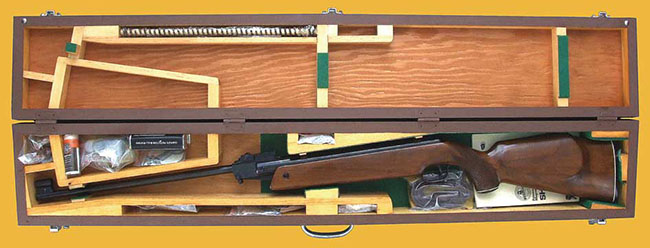
The man who bought this 124 made a case for it and stored all the parts needed to rebuild it over the years. Unfortunately he didn’t know that the piston seals would dry-rot inside the case.
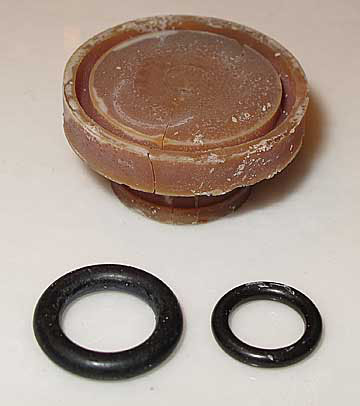
After a couple decades, the 124 seals dry-rotted. The o-rings were made from a different material and are still fine.
Diana changed seals material
I don’t know when it happened but by 1984 Diana had discovered the faulty seal material and had switched to a different material that seems to last indefinitely. The Diana 34 was the first rifle with the new seal material.
I knew this Beeman 800 could shoot a pellet out of the barrel, so that meant it had modern seals. But today’s test is also to check the health of the remainder of the powerplant. It isn’t just seal material that I’m testing.
Remember the Diana 75 target rifle I reported on years ago? It has modern seals, but it still shoots way too slow. It’s fully 150 f.p.s. slower than it should be. So even modern piston seals can have problems — hence the test.
Choice of pellets
I selected a lightweight synthetic pellet, a medium weight one and what is considered a heavy pellet for a powerplant in the Beeman 800’s category. I know many people shoot target pistols with domed pellets, but I don’t, so all three pellets tested today are wadcutters.
Sig Match Ballistic Alloy
First to be tested was the lead-free Sig Match Ballistic Alloy pellet that weighs 5.25 grains. More often these days I’m seeing where lead-free pellets are mandated, so this is a legitimate test for a target pistol. My other Diana model 6 averaged 514 f.p.s. with this pellet. This Beeman 800 (also a Diana 6) averaged 478 f.p.s. The spread sent from a low of 471 to a high of 485 f.p.s. That’s a difference of 14 f.p.s. This pistol doesn’t have quite the velocity of the other model 6 but it’s close enough that we know it’s healthy.
RWS Club
The RWS Club pellet weighs 7 grains and is in the middle of the weight range for pellets I consider appropriate for this pistol. Many target pistol pellets also weigh 7 grains. I will show you the entire shot string because something interesting happened.
Shot…………Vel.
1………………419
2………………415
3………………417
4………………415
5………………426
6………………417
7………………391 — woah!
8………………407
9………………400
10…………….395
The average for this string is 410 f.p.s. The low is 391 and the high is 426. That’s a difference of 35 f.p.s. But what happened on shot number seven? I will come back to it in a bit, but THIS is a great reason to own a chronograph!
Norma S-Target Match
The Norma S-Target Match pellet weighs a nominal 8.2 grains which is around the top weight I consider appropriate for an air pistol like this. Ten pellets averaged 342 f.p.s. with a spread that went from a low of 334 to a high of 353 f.p.s. That’s an 18 f.p.s. difference.
Are the seals going bad?
When piston seals go bad sometimes there is a linear drop in velocity like we saw with the RWS Club pellet. A way to test this is to shoot more of them and see where they are. So I shot five more. Here is that string.
Shot…………Vel.
1………………431
2………………409
3………………428
4………………425
5………………411
From what this string shows, you can see that this pistol is simply erratic with the RWS Club. It clearly is not loosing velocity; it just doesn’t seem to like this pellet.
Note to self
I think I will put the RWS Club into the accuracy test, alongside some premium target pellets that I expect to do well. That should be interesting because it should address whether a wild velocity variation will cause a larger group size (less accuracy) at just ten meters distance. But we also know that the RWS Club is an economy pellet, so this test will be very subjective.
Cocking effort
The other Diana 6 cocked with 29 pounds of effort. This one just touched 30 pounds one time, but the scale hovered around 26 pounds the rest of the time. The fat and rounded front sight globe gives a great place to hold the barrel during cocking.
Speaking of the front sight, reader Ian McKee is sending me some front sight inserts to test in this pistol. The sight element that’s in there now doesn’t reach the center of the globe and looks strange when I aim the pistol.
Trigger pull
The trigger pull is two-stage, but stage two is not much heavier than stage one. Stage one takes 1 pound one ounce (482 grams) and stage two breaks at 1 pound 11 ounces (765 grams). Stage two is a bit heavy for a 10 meter pistol whose legal weight should be as low as 500 grams, but as little as I shoot this pistol, I find the additional weight to be a safety factor. I’m leaving it where it is for now.
What you should have learned
Today wasn’t just about testing an obsolete air pistol. It was much more than that. It was about using a chronograph to diagnose the health of a spring-piston powerplant and recognizing that pellet choices do make a difference. It was also about leaving things like trigger weight adjustments alone until you have had the opportunity to test the trigger during accuracy testing.
Summary
It seems this Beeman 800/Diana model 6 air pistol is in fine shape. And yes, I acknowledge that this one is based on the model 6G, but in terms of the powerplant, it’s simply a Diana model 6.
Today’s test means we are ready to proceed to the accuracy test.
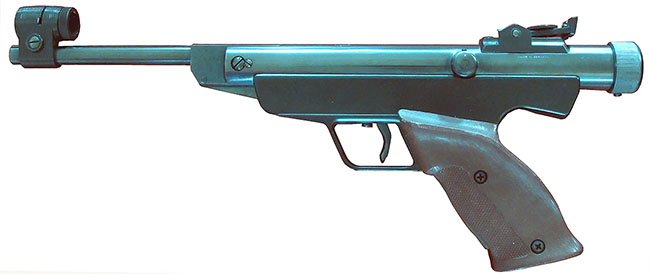
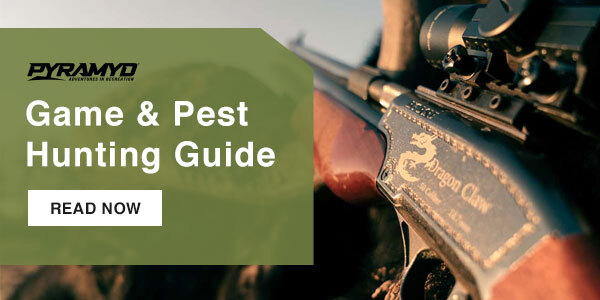
B.B.
I’m a firm believer that target springer airgun pistols should shoot a pellet with a 7 handle. They are accurate, just not powerful. Also, a ton of fun to shoot! Will this be single handed or two handed shooting for accuracy?
-Yogi
Yogi,
It’s about the airgun — not me. It will be a rested hold with two hands.
BB
BB,
Maybe I’m getting old, but I really enjoy it when you test old classics like this one; thank you. 🙂
I’m looking forward to the accuracy test; I see Yogi’s comment on methodology.
Personally, I hope you shoot with 2 hands off a rest.
I know it’s meant to be shot one-handed in competition.
But for accuracy, I like to see the best the gun can do with as many human factors as possible removed.
*shrugs* What do I know? LOL! 😉
Blessings to you,
dave
Brother dave,
Apparently you know a lot! 😉
BB
…only because I am learning at the feet of the master, the Godfather of Airguns. 😉
Thanks for the interesting report. Did you notice any fit differences when loading the RWS Club pellets into the gun? Were some of them noticeably a little tight or loose or noticeably different from the other pellets? Looking forward to the accuracy tests.
Elmer,
All the pellet fit the bore loosely.
BB
BB
This report is rekindling my thoughts about my chronograph. Mine is the screen type and while reliable it isn’t handy when shooting for score (I’m only aiming to miss those screens). Other chronograph types that attach near the muzzle may not interfere with target shooting. I want to know how much correlation there is between velocity and fliers. I’m only guessing not much at 10 meters. But you will test this if I understand your intent.
Like many who comment I love seeing tests on the older guns, especially the target guns with their wonderful triggers.
PS: For this test shooting from a rest is essential. Your pistol competition history says plenty about your ability.
Deck
Deck,
I have an older chrony with screens as well. If you set it up correctly, you can shoot at targets and still not hit the screens. It just takes a little more time.
Just for clarity’s sake, I do not do this anymore, but I have in the past. More shooting is better. 😉
RidgeRunner
Our host and others have said sooner or later the screens suffer. So far I have been fortunate but the easiest chrony shooting setup from my deck is to shoot between the Chip and Dale deck railings. Those railing are only inches apart and just begging to get shot.
I think the FX chrony would allow me to shoot normally from deck rail top. But I do wonder if the extra weight hanging from the muzzle end of barrel would change harmonics.
Deck
The new radar-based chronographs seem to be the way to go, but most of them do require having one of them so called “smart” phones to use such. Since that is not likely to happen here at RidgeRunner’s Home For Wayward Airguns and RidgeRunner’s Halfway House for Modern Magnums, I will just have to hope that I continue my missing of the chrony.
Many of the video reviewers have been mounting the FX chrony on a small tripod instead of fastening it to the barrel.
RidgeRunner,
LIGHTLY used first version LabRadars are going on sale for really cheap all over the place! The prices are really good already (US $250 with a bunch of accessories) and they are not being snapped up!
Of course the real problem is that they only work some of the time according to the INFLUENCERS!
OF course the actual problem with the ORIGINAL LabRadar is you need to read and understand the Quick Start…or heaven forfend…READ THE OWNERS MANUAL… there by losing all your street cred.
Still it is the only Consumer Doppler RADAR CHRONOGRAPH that computes Coefficient of Drag and provides ACTUAL projectile Ballistic Coefficient (BC) for your gun and projectile!
gun shows and airgun shows should have bunches for sale…easy to spot with that BRIGHT orange color…maybe the manufacturer should have done some in CAMO!
shootski
I have seen and used a LabRadar before. They are waaaaaaaay more than I need. My Caldwell does just fine.
BB,
Thank you once again for telling us about this “old gal”. I do so enjoy knowing more about them as I know a few others around here do.
Whether this old curmudgeon likes it or not, the newer PCP target rifles and pistols are indeed more accurate than the old sproingers.
Now, are the new sproingers more accurate than the old sproingers and are the new PCPs more accurate than the old PCPs? Some are and some are not. There are two major factors involved, both of which are related to manufacturing and the effort that is put forth during such.
One is the ammunition. There have been great advancements in the design and manufacturing of such. Not much real care was put into the early projectiles, but today the top shelf stuff is truly top shelf. The design, manufacture and testing of today’s projectiles is indeed incredible. Yes, we pay for it, but the results are indeed incredible.
With this modern ammunition I am frequently achieving results with some of these finer made “old gals” that are truly astounding.
Another factor is whether the manufacturer is paying real close attention to the quality of the manufacture of the airguns. Is the design suitable to give optimum performance?
How close is the manufacturing team keeping to the tolerances? How consistent is the manufacturing? These and other factors will have a huge bearing on whether a sproinger or PCP model is accurate or not.
Many of us old curmudgeons have learned these things over the years. Many of the newbies still have to learn this.
B.B.,
I am going to go out on a limb and predict that even fairly wild excursions in Muzzle Velocity (MV) from shot to shot at ten meters. Even with the potential of barrel oscillations is similar to speeding on short trips in vehicles that doesn’t get you there all too much faster! We most all now from experience that on longer trips speeding becomes a significant time saver.
So what does this have to do with shooting pellets some might ask… well, other than the WIND the force of Gravity is what determines most of the trajectory of the projectiles and group size if we hold well.
At ten meters the flight time to the Target is under 0.16 MS (milliseconds) at a very sedate 200’/second MV…not much time for Gravity (and even the WIND) to cause that pellet to drop (move sideways or some other direction) toward the bottom of the bullseyes.
erratum:
Sig Match Ballistic Alloy
The spread sent (went) from a low of 471 to a high of 485 f.p.s. That’s a difference of 14 f.p.s.
shootski
Guess I forgot how to reply, See below
Shootski
I think .16 seconds or a little over 5 inches at 200 ft/sec
Time for 10 meters and drop in vacuum
471 fps = 0.0696 seconds = 0.935 inches
485 fps = 0.0676 seconds = 0.882 inches
Difference = 0.053 inches
Is that significant? Depends
Don
Benji-Don,
It seems so.
Although, as well as i shoot a pistol these days it might not even be apparent to me.
More importantly were you and family impacted by the wildfires?
I hope all is good.
shootski
Readership,
IF you wanted a NEW Original LabRadar they are having a Moving Sale! US $ 349.95
shootski
Shootski,
Thanks for thinking about us. So far no fires too near and favorable winds blowing away. The season is just getting started though. The poor firefighters are already wore out.
I should have set up a spread sheet I’m curious what the difference would be at longer distances. May need to account for the bc as the faster velocity would slow more than the slower velocity. That is stating to give me a calculus headache. I’m thinking the bc may not be that significant unless there is a very large velocity difference. In which case get a better gun.
Don